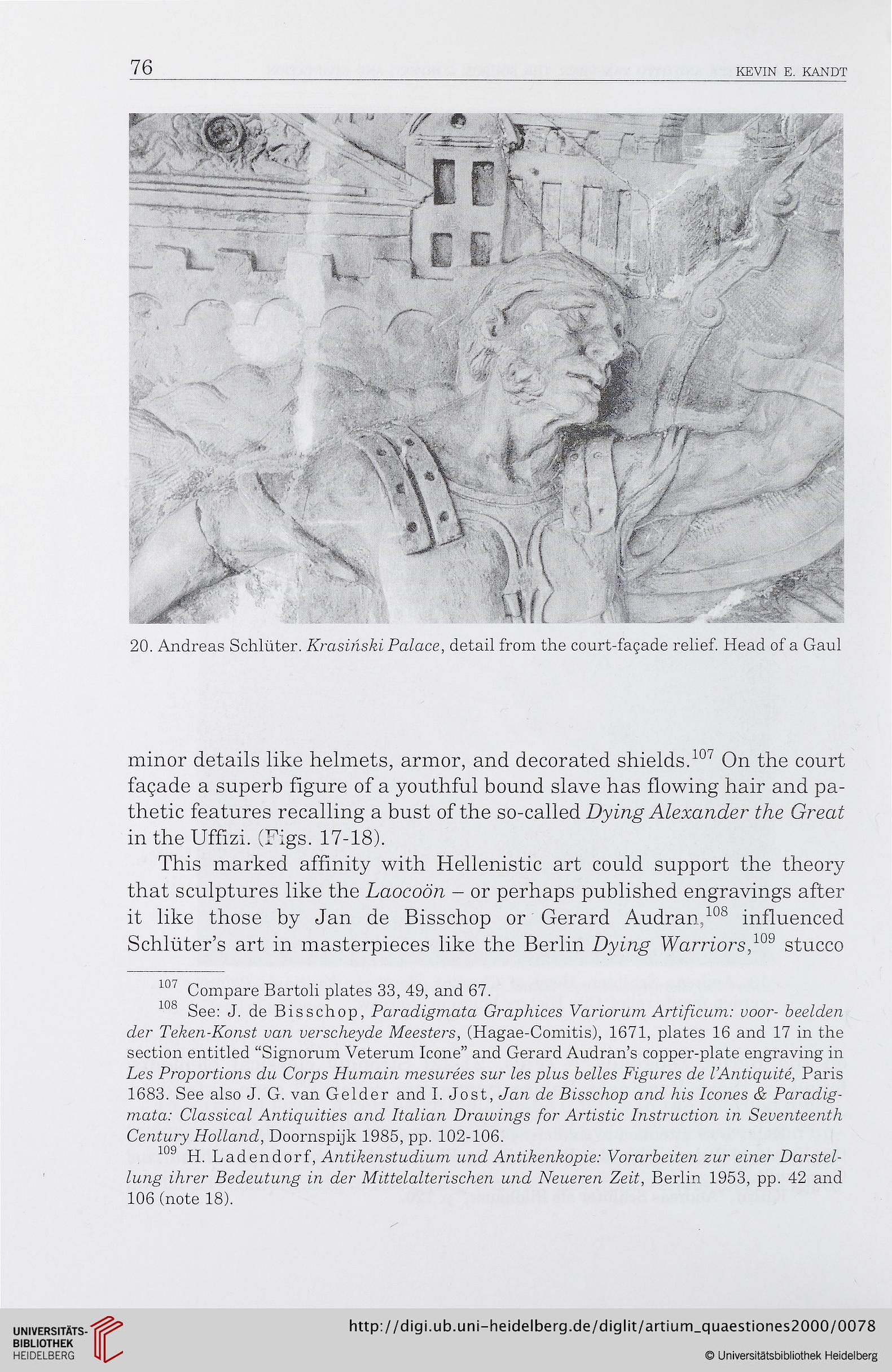76
KEVIN E. KANDT
IJvV
20. Andréas Schlüter. Krasinski Palace, detail from the court-façade relief. Head of a Gaul
fi;
minor details like helmets, armor, and decorated shields.10' On the court
façade a superb figure of a youthful bound slave has flowing hair and pa-
thetic features recalling a bust of the so-called Dying Alexander the Great
in the Uffizi. (Figs. 17-18).
This marked affinity with Hellenistic art could support the theory
that sculptures like the Laocoôn - or perhaps published engravings after
it like those by Jan de Bisschop or Gérard Audran.,106 influenced
Schlüter’s art in masterpieces like the Berlin Dying Wat'riors,* 108 109 stucco
10' Compare Bartoli plates 33, 49, and 67.
108 See: J. de Bisschop, Paradigmata Graphices Variorum Artificum: uoor- beelden
der Teken-Konst van verscheyde Meesters, (Hagae-Comitis), 1671, plates 16 and 17 in the
section entitled “Signorum Veterum Icône” and Gérard Audran’s copper-plate engraving in
Les Proportions du Corps Humain mesurées sur les plus belles Figures de l’Antiquité, Paris
1683. See also J. G. van Gelder and I. Jost, Jan de Bisschop and his Icônes & Paradig-
mata: Classical Antiquities and Italian Drawings for Artistic Instruction in Seventeenth
Century Holland, Doornspijk 1985, pp. 102-106.
109 H. Ladendorf, Antikenstudium und Antikenkopie: Vorarbeiten zur einer Darstel-
lung ihrer Bedeutung in der Mittelalterischen und Neueren Zeit, Berlin 1953, pp. 42 and
106 (note 18).
KEVIN E. KANDT
IJvV
20. Andréas Schlüter. Krasinski Palace, detail from the court-façade relief. Head of a Gaul
fi;
minor details like helmets, armor, and decorated shields.10' On the court
façade a superb figure of a youthful bound slave has flowing hair and pa-
thetic features recalling a bust of the so-called Dying Alexander the Great
in the Uffizi. (Figs. 17-18).
This marked affinity with Hellenistic art could support the theory
that sculptures like the Laocoôn - or perhaps published engravings after
it like those by Jan de Bisschop or Gérard Audran.,106 influenced
Schlüter’s art in masterpieces like the Berlin Dying Wat'riors,* 108 109 stucco
10' Compare Bartoli plates 33, 49, and 67.
108 See: J. de Bisschop, Paradigmata Graphices Variorum Artificum: uoor- beelden
der Teken-Konst van verscheyde Meesters, (Hagae-Comitis), 1671, plates 16 and 17 in the
section entitled “Signorum Veterum Icône” and Gérard Audran’s copper-plate engraving in
Les Proportions du Corps Humain mesurées sur les plus belles Figures de l’Antiquité, Paris
1683. See also J. G. van Gelder and I. Jost, Jan de Bisschop and his Icônes & Paradig-
mata: Classical Antiquities and Italian Drawings for Artistic Instruction in Seventeenth
Century Holland, Doornspijk 1985, pp. 102-106.
109 H. Ladendorf, Antikenstudium und Antikenkopie: Vorarbeiten zur einer Darstel-
lung ihrer Bedeutung in der Mittelalterischen und Neueren Zeit, Berlin 1953, pp. 42 and
106 (note 18).





